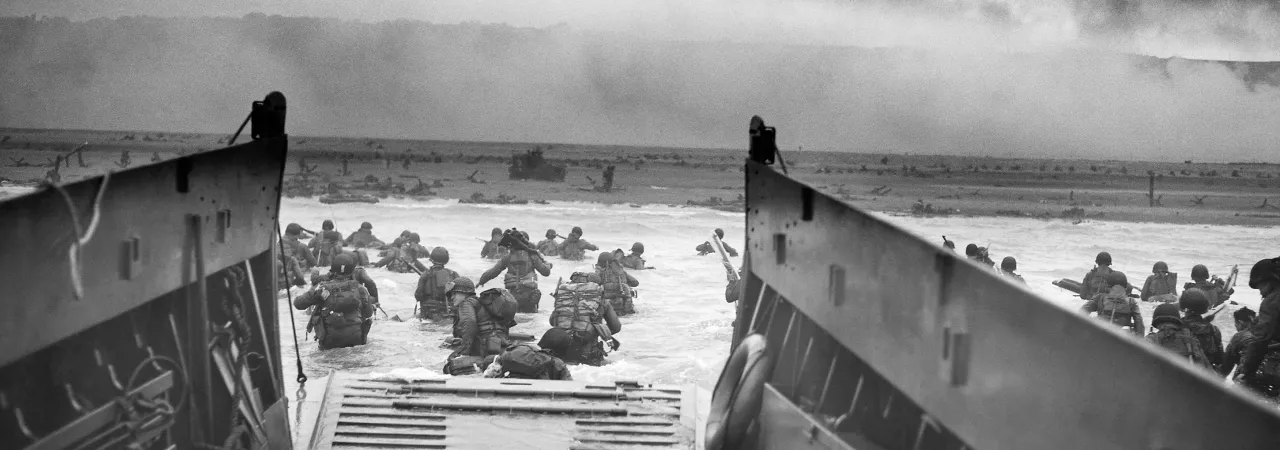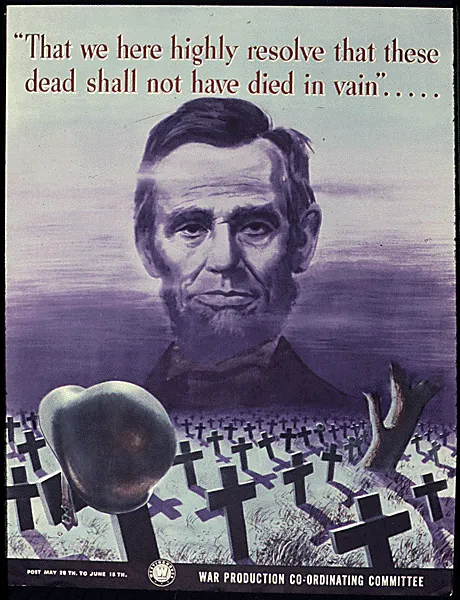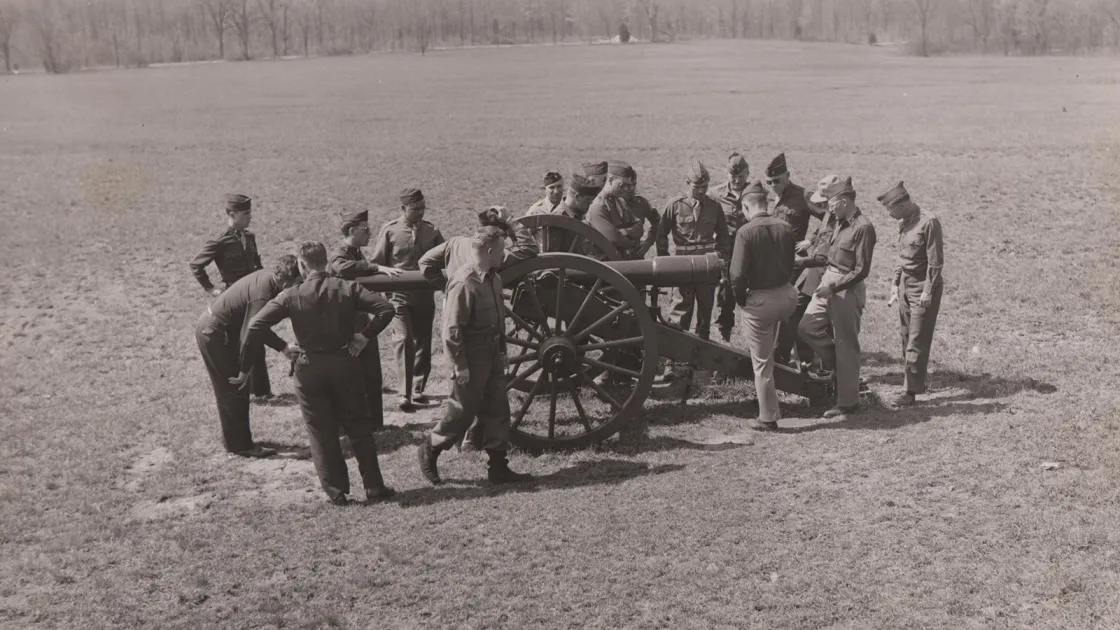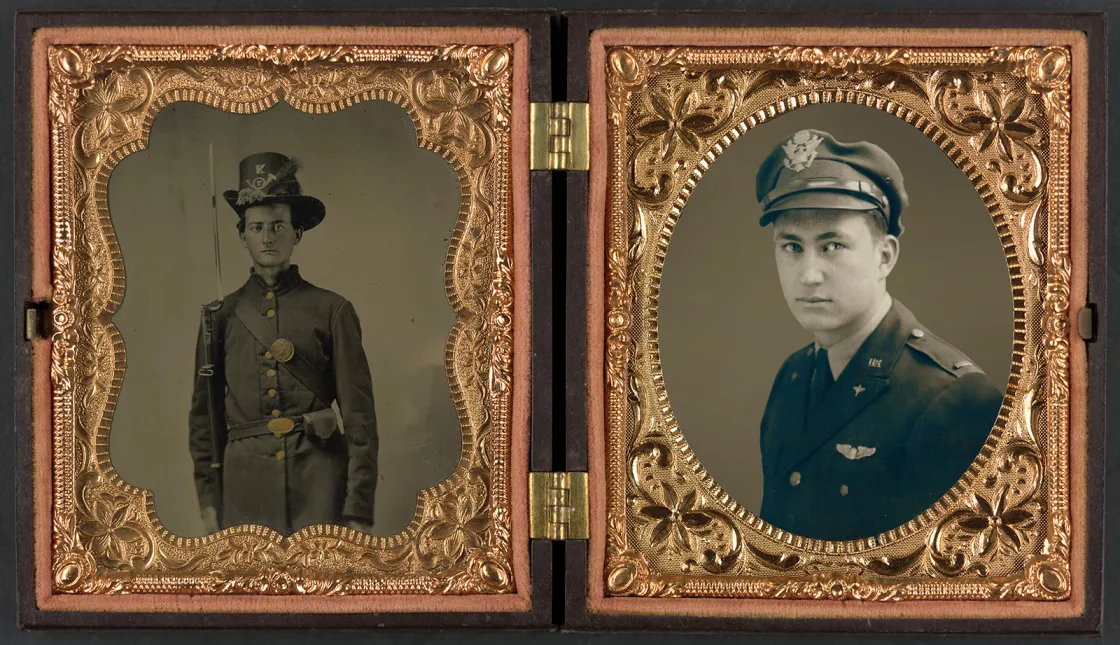Great Tasks, Great Crusades: D-Day and the Shadows of the Civil War

“The Battle of Gettysburg must have been duck soup compared to this kind of fighting.” Such was the response of Private Dale E. Cluck to a fierce German counterattack in the hedgerows of Normandy. A mere seventy-five years after the United States destroyed slavery and preserved the Union, another righteous struggle ensued as the American people engaged in the bitter contest against totalitarianism. As the world went to war for a second time in the 20th century, the War of the Rebellion stood as a hallmark moment in the course of human destiny. Winston Churchill referred to the Civil War as “the noblest and least avoidable of all the great mass conflicts of which till then there was record.” Likewise, Franklin Roosevelt echoed Lincolnian rhetoric at Gettysburg’s 75th anniversary when he announced citizens required the “practical devotion to attain and to retain that greatest good for the greatest number which this government of the people was created to ensure.”
Memories of the Civil War’s moral imperative were perhaps no more vivid than in the spring and summer of 1944. The world held its breath as hundreds of thousands of Allied service members leapt across the English Channel in the largest amphibious operation of the Second World War. For Americans, the saga of the Normandy invasion — already legendary in myth and astounding in scope — mirrored the heroics, carnage, and frustrations experienced in their own country eight decades prior.
Similar to the 1860s efforts in preserving democracy or advocating abolition, citizens of the 1940s collectively embraced D-Day as a foundation for societal progress. The invasion instilled devout purpose and compelled citizens to seek higher meaning from the war. D-Day served as the national compass pointing to inevitable victory and prospects of peace. At this critical hour, Americans reinvested themselves in the war effort and sought to perfect their world in Operation Overlord’s wake. Citizens were both inspired and distressed by what this future might entail. In light of these events, the past served as a form of consolation.

Summoning the spirit of the Gettysburg Address, General Dwight D. Eisenhower — an avid student of the Civil War who trained at Gettysburg — crafted a concise, meaningful declaration of purpose on the eve of D-Day. His 236-word rallying cry encouraged the pursuit of a principled ideal. The prose was promptly embraced as American Scripture, extolling the virtues of free society by denouncing oppression. Through thousands of leaflets and a sobering yet uplifting radio broadcast, Eisenhower shared a vision for a world that many of his men would never see.
Appealing to the soldiers, sailors, and airmen of his vast armada, the supreme commander invoked religious connotations, calling their months-long mission a “Great Crusade.” The arduous task of liberating the downtrodden from tyranny would be painful and costly. Yet, as the noose stiffened around the Axis domain, Eisenhower recognized that the tide had turned. The Allied coalition forged by determination was soon to rebound from the stark tragedies of Dunkirk and beyond. “The free men of the world are marching together to victory.” As Lincoln alluded to four score and one year earlier, such timeless struggles against despotism had the potential to usher “a new birth of freedom” for untold generations.
Words matter — and they often fall short during momentous times in history. The San Francisco Chronicle, however, recognized the Gettysburg Address and Eisenhower’s Order of the Day as “exceptional cases when the words matched the times.”
***
Beyond the noble urgency of liberation, the Civil War and World War II exhibited exemplary blueprints of leadership. As Great War veteran and former Ike subordinate Glenn Hutton surmised, “We can only well speculate that Gen. Eisenhower while planning the North African campaign, the Sicilian campaign, the Italian drives and the great campaigns of Europe had ever in his mind the efforts of the Civil War heroes of Gettysburg.”
According to author Stephen Ambrose, “D-Day, June 6, 1944, was for Eisenhower what May 3, 1864, was for Grant, the beginning of the critical climactic campaign of the war. Each general was at the peak of his powers, physically fit, mentally alert, morally confident in himself and his cause. Each had traits that inspired confidence.... As with Eisenhower, when Grant entered a room all eyes turned to him.” Both generals had the ability to react quickly, learn from error, decipher information, and press on in the face of adversity—the “essence of command.” Meanwhile, reporters likened Sir Bernard Law Montgomery to “Stonewall” Jackson because the minister’s son-turned-field marshal hailed from a long lineage of “sword and Bible generals.”
Several of Eisenhower’s kin had served in Pennsylvania regiments in the 1860s and, as a schoolboy in Abilene, Kansas, the future general had listened to many veteran tales firsthand. By the 1940s, however, exceedingly few warriors of the Blue and Gray remained. As of March 1944, the New York Times reported that only some 400 Federal veterans were still collecting pensions. For countless GIs, stories of their Civil War ancestors were faint childhood memories or nostalgic family folklore. Joseph Stanley Pennell, an American lieutenant in an antiaircraft battalion, penned the novel The History of Rome Hanks and Kindred Matters in 1944 to revisit his genealogical past. The book’s protagonist seeks to uncover the experiences of his Civil War veteran grandfathers as his narration sifts between the two conflicts — illustrating the universality of wartime regardless of the era.

Despite the importance of history and familial ties, the War Department encouraged Americans preparing for invasion in England to forget conflicts of the past. A Short Guide to Great Britain declared, “If you come from an Irish-American family, you may think of the English as persecutors of the Irish, or you may think of them as enemy Redcoats who fought against us in the American Revolution and the War of 1812. But there is no time today to fight old wars over again or bring up old grievances. We don’t worry about which side our grandfathers fought on in the Civil War, because it doesn’t mean anything now.”
Many disagreed with that sentiment. The Normandy invasion provided a final, grand moment of introspective oratory for the dwindling ranks of America’s deadliest conflict. Aged Civil War veterans could not help but draw parallels between D-Day and the momentous battles of their youths. Newspapers actively sought their seemingly divine commentary.
Former drummer boy John C. Adams of the 17th West Virginia Volunteer Infantry was none too impressed by contemporary GI Joes, thinking them somewhat wimpish. “They don’t have to eat hardtack, the girls dance with them, and they are being rehabilitated,” the ancient warrior later complained to a reporter. “These GIs had it sort of easy that way.” Adams died in 1949 at age 101, purportedly the last Civil War veteran living in Indiana.
D-Day became the bloodiest day in American military history perhaps since Antietam. In a sad twist of fate, the psychological tolls of the Normandy invasion may have killed one inconsolable Civil War veteran. Ringgold W. Carman, who enlisted in the 124th Pennsylvania Infantry at age 16, descended into “a depressed state of mind caused by the news of D-Day from the battlefields in France,” reported the New York Times. Now 100 years old, he followed war news with great interest and chronicled the advances of armies on a large wall map in his Queens, New York home.
Upon hearing of D-Day on the radio, he immediately telephoned his daughter and despondently remarked, “I saw 24,000 dead on the field at Antietam. This is going to be worse.” Over the following week he “slumped into a stupor from which he did not rally.” Carman passed away on June 16 as one of the last Civil War veterans of New York City. The thought of Americans experiencing carnage similar to what he endured was too much to bear. Elliott P. Taylor, a former member of the 4th Iowa Cavalry, may have suffered a more acute shock from the invasion. The 98-year-old died on June 6 shortly after learning D-Day had commenced.
Anxieties of armed conflict long resonated with Carman. The Brooklyn Daily Eagle reported of his angst as early as June 1940. “The troubling belief that America is at the crossroads,” observed the Eagle, “that the future of our country for the next century or two is poised in the scales of warfare which younger men are experiencing for the first time in their lives is a familiar state of mind to the Civil War veteran.” Nonetheless, Carman believed that “In union there is strength.” These words still rang true in 1944.
***
While military actions stirred consternation in some of the Civil War generation, they instilled patriotic fervor in others. Veteran Charles L. Chappel, age 97 of Long Beach, California, described himself as “the only Civil War veteran who lives alone, does all his own work, and has time to raise a Victory garden.” Chappel had his own chickens and harvested 110 pounds of grapes the prior year to make jelly. In the farmer’s view, his self-dependency allowed for just a bit more food to be shipped overseas to the boys who needed it most.
Dr. James H. Garnett, a former slave who escaped a Georgia plantation to join the Union Army at age 17, likewise wished to nurture confidence in the ranks of the Armed Forces. Annually riding in a lead car of Gary, Indiana’s Memorial Day Parades, his presence demonstrated the ability of people to overcome adversity and injustice. Garnett helped secure his own freedom with his own hands, obtained a doctorate, and headed a theological seminary. Four days after D-Day, the Indianapolis Recorderwrote of the 96-year-old reverend, “Garnett follows the war with keen interest. Each Allied victory thrills him; each setback worries him. One of Dr. Garnett’s correspondents is an army chaplain in the European theater, and his letters interest him especially. He was amazed when he first saw V-Mail but now accepts it as ordinary.”
Equally dedicated to the war effort was Helen Longstreet, widow of Robert E. Lee’s “Old War Horse” general. Although wartime rationing had squashed the hopes of erecting a statue to her husband at Gettysburg, the “Fighting Lady” had plenty to keep her busy. Employed as a riveter at a Bell bomber plant near Atlanta, she departed her wartime home at a Marietta trailer park every morning in denim coveralls. “I am majoring in assembly, fabrication, and riveting,” boasted the 81-year-old. “The [factory] course usually requires three months, but I believe I will be ready in two weeks.” Despite plant supervisors requesting her resignation due to age, Longstreet refused to quit and subsequently became embroiled in a labor union dispute over the issue.
Like their Federal counterparts, former Confederates did not hesitate in sharing thoughts of D-Day. The 98-year-old Julius F. Howell, formerly of the 24th Virginia Cavalry, appeared in the U. S. House of Representatives on June 8, “resplendent in a Confederate gray dress uniform, to plead for national unity in the fight against the Axis.” The congressmen courteously obliged the veteran, dispensing with rules prohibiting non-members from speaking. The irony of an ex-Confederate calling for the liberation of oppressed peoples was realized by few in the audience—with the possible exception of Congressman William Dawson. As the lone African American member of the House, Dawson used D-Day’s political capital to invoke equality and themes of the Gettysburg Address. “American boys, black and white, are in the vanguard. Many will die,” he remarked. “If by their death the Freedoms are brought to Mankind everywhere, they, indeed, shall not have died in vain. Our hopes and prayers are with them.” Dawson highlighted the contradiction that white and black soldiers were permitted to die together but not live together.

Despite the earlier heroics of the 54th Massachusetts, the 4th United States Colored Troops, and countless African American regiments in the Civil War, black and white soldiers remained segregated as D-Day unfolded. Amidst this paradox, Michigan’s Benton Harbor News Palladium celebrated what seemed the death knell of America’s most unsavory Civil War legacy—the Ku Klux Klan. The KKK, which once boasted 5 million members and held toxic strangleholds on state governments, appeared to fade from prominence. Only days after the invasion, Klan leadership announced the league of fanatics would “meet and reincarnate” when the pressures of war subsided. “Probably Adolf Hitler never heard of the Ku Klux Klan, but the Klan and Hitler’s Nazi party were blood relations,” wrote the Palladium.
Hitler himself might have agreed. The fuehrer declared of the American Civil War in 1933, “The beginnings of a great new social order based on the principle of slavery and inequality were destroyed by that war, and with them also the embryo of a future truly great America that would not have been ruled by a corrupt caste of tradesmen.” D-Day, much like the 13th Amendment, had the potential to serve as a nail in the coffin of supremacist rule.
In the style of William Lloyd Garrison’s abolitionist periodical The Liberator, the Pittsburgh Courier contended it was time for America to prioritize and cease waging war on the black man: “On the Normandy beachhead on D-Day, whom did the white soldier from Georgia or Florida fear the more, the armed Negro beside him, or the German, who is white like himself?” Although World War II would serve as a foundation for the broader civil rights movement, notions of liberty nonetheless outlined extraordinary limitations. Twenty-five African Americans were awarded Medals of Honor as a result of actions in the Civil War. Due to systemic racism within the War Department, no black service member of World War II was presented that same distinction until 1997.
***
As his forces embarked upon their gallant journeys across the English Channel, Ike drafted a letter for the possibility of failure. Inadvertently dating his admission of responsibility July 5, he warily wrote, “Our landings in the Cherbourg-Havre area have failed to gain a satisfactory foothold and I have withdrawn the troops. My decision to attack at this time and place was based upon the best information available. The troops, the air and the Navy did all that bravery and devotion to duty could do. If any blame or fault attaches to the attempt it is mine alone.” Eisenhower’s self-accountability was one of many traits that earned him endearment.
Similar responsibility could be witnessed in Robert E. Lee’s direction of the Army of Northern Virginia. Beyond his purported confession of “It is all my fault” at Gettysburg, Lee wrote the following of his men in a resignation letter to Jefferson Davis on August 8, 1863: “Nothing is wanted, but their fortitude should equal their bravery to insure the success of our cause. We must expect reverses, even defeats. They are sent to teach us wisdom and prudence, to call forth greater energies and to prevent our falling into greater disasters.” Generalship can be a lonely burden—a pressure experienced by both Lee and Eisenhower in their respective wars. The successes and failures of armies are chiefly dictated not by the soldiers in the ranks but the commanders who lead them. Gratefully, Ike’s emulation of Lee’s confession was rendered unnecessary. Eisenhower’s ethical crusade would bear fruit in a manner that Lee’s invasion of Pennsylvania never could.
Profound links between the wars were often highlighted in tragic ways. Lt. Colonel John J. “Jack” Toffey, III hailed from an illustrious military family. Toffey’s grandfather and namesake received the Medal of Honor for deeds at the Battle of Chattanooga. The grandfather survived his war. The grandson did not. A leader in the 3rd Infantry Division’s 7th Regiment, Toffey was struck down by German fire in Italy three days prior to the Normandy landings. He, too, perished on behalf of the “unfinished work” Lincoln heralded in 1863. Appropriately, countless thousands of those Americans claimed by the Second World War were laid to rest alongside their brothers in blue throughout national cemeteries established during the Civil War. More fitting bedfellows can hardly found in their eternal repose. Although marked by different dates, each white tombstone tells a tale much like the other.






